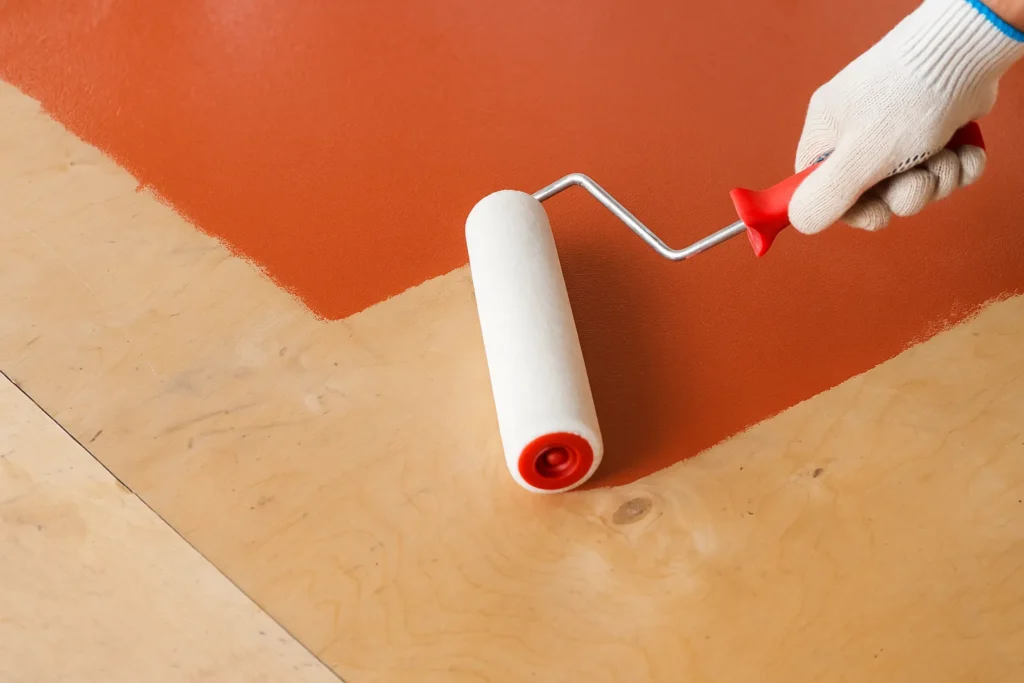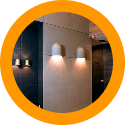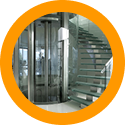Plywood floors are common in older Brooklyn brownstones, Queens residential properties, and Manhattan loft conversions. Many property owners across New York City wonder if epoxy floor coating over plywood is viable.
The answer is yes, epoxy flooring on wood substrates works exceptionally well when installed correctly. NYC homeowners in neighborhoods like Williamsburg, Astoria, Park Slope, and the Upper West Side have successfully transformed aging plywood subfloors into durable, attractive surfaces.
What Is Epoxy Floor Coating Over Plywood?
Epoxy floor coating over plywood involves applying specialized resin systems directly onto wood substrates. This process creates a seamless, waterproof surface that protects underlying plywood from moisture damage.
The technique is particularly valuable in New York City’s humid climate. Brooklyn, Queens, and Staten Island properties face unique moisture challenges that make protective coatings essential.
Why Choose Epoxy Over Plywood Floor in NYC?
Traditional flooring options often fail on plywood substrates in New York environments. Epoxy on plywood floor provides superior moisture resistance compared to conventional finishes.
Manhattan apartment renovations frequently incorporate epoxy plywood floor systems. The Bronx industrial spaces also benefit from this durable flooring solution.
Moisture Protection Benefits
New York City experiences significant humidity variations throughout the year. Epoxy paint for plywood floors creates an impermeable barrier against water infiltration.
This protection is crucial for basement applications in Queens and Brooklyn. Ground-level spaces in Staten Island also require robust moisture management.
Durability in High-Traffic Areas
Commercial properties in Manhattan’s Midtown and Financial District demand resilient flooring. Epoxy flooring over wood handles heavy foot traffic better than traditional wood finishes.
Retail spaces in SoHo and Chelsea benefit from epoxy’s scratch resistance. Restaurants in the Bronx’s Little Italy also choose epoxy for kitchen and dining areas.
Cost-Effective Installation
Replacing plywood subfloors throughout New York City properties is expensive. Epoxy over subfloor systems eliminate the need for complete substrate removal.
Brooklyn renovation projects save thousands by coating existing plywood. Queens homeowners avoid costly demolition with epoxy paint on plywood floor applications.
Two Primary Installation Methods for Epoxy Flooring on Wood
Professional installers in New York City use two distinct approaches for epoxy floor over plywood. Each method addresses specific project requirements and substrate conditions.
The choice between techniques depends on floor condition, budget, and performance expectations. Manhattan contractors evaluate these factors before recommending an approach.
Method 1: Self-Leveling Concrete Base System
This approach involves installing self-leveling concrete over plywood before applying epoxy. The concrete layer creates a stable, alkaline surface ideal for epoxy adhesion.
Brooklyn contractors frequently use this method for commercial applications. The Bronx industrial facilities also prefer this robust system.
Installation Process:
- Sand the plywood thoroughly with 40/60 grit power floor sanders
- Remove all existing finishes and create surface texture
- Secure any loose planks with appropriate fasteners
- Install diamond metal lath across the entire surface
- Pour minimum ½-inch self-leveling concrete (Param 4500 or equivalent)
- Allow concrete to cure per manufacturer specifications
- Apply primer coat to prepared concrete surface
- Install epoxy coating system in multiple layers
Queens warehouse conversions benefit from this method’s structural reinforcement. Staten Island commercial spaces use this system for maximum durability.
Method 2: Flexible Epoxy Direct Application
The second technique applies flexible epoxy coating directly onto prepared plywood. This method works well for residential applications with stable substrates.
Manhattan apartment renovations often choose this streamlined approach. Brooklyn brownstone owners appreciate the reduced installation time.
Installation Process:
- Clean plywood surface thoroughly with appropriate cleaning agents
- Sand entire floor with power equipment (40/60 grit)
- Fill large cracks with wood patching compound
- Allow patching compound to cure completely
- Sand patched areas flush with surrounding surface
- Vacuum all dust and debris from sanding operations
- Apply wood sealant to address moisture concerns
- Install wood primer for enhanced adhesion
- Apply flexible epoxy coating system
- Add topcoat for protection and aesthetics
This method suits residential projects in Astoria, Park Slope, and Crown Heights. The streamlined process reduces project timelines for occupied spaces.
Essential Materials for Epoxy on Wood Floor Installation
Professional epoxy installation requires specific materials and tools. New York City contractors maintain comprehensive equipment inventories for efficient project completion.
Quality materials ensure long-lasting results in demanding NYC environments. Manhattan, Brooklyn, and Queens projects demand premium products.

Surface Preparation Materials
- Industrial-grade bleach for cleaning and disinfecting surfaces
- Power floor sanders with 40/60 grit capability
- Wood patching compound for crack and gap repair
- Commercial vacuum systems for dust collection
- Wood sealant products for moisture management
Brooklyn contractors stock these essentials for rapid project deployment. The Bronx installation teams maintain similar inventories.
Application Materials and Tools
- High-quality paintbrushes for edge work (3-inch recommended)
- Professional-grade paint rollers with appropriate nap
- Wood primer specifically formulated for epoxy compatibility
- Epoxy floor coating systems (clear or pigmented options)
- Mixing equipment for proper epoxy preparation
Manhattan suppliers provide same-day delivery throughout the five boroughs. Queens and Staten Island contractors access materials through local distribution networks.
Safety Equipment
New York City building codes require appropriate safety measures during installation. Contractors must provide adequate ventilation during epoxy application.
Respiratory protection is mandatory when working with epoxy systems. Brooklyn, Queens, and Manhattan projects follow strict safety protocols.
Detailed Preparation Process for Plywood Substrate
Proper surface preparation determines epoxy flooring success. New York City’s experienced contractors emphasize thorough prep work.
Rushing preparation compromises adhesion and long-term performance. Manhattan and Brooklyn projects allocate sufficient time for proper surface preparation.
Surface Cleaning Protocol
Begin by removing all furniture, fixtures, and movable items. Brooklyn brownstone projects require careful protection of architectural details.
Clean the plywood surface with bleach solution to eliminate mold. Queens basement applications particularly benefit from antimicrobial treatment.
Allow surfaces to dry completely before proceeding. New York City’s humid conditions may require extended drying periods.
Sanding Requirements
Power sand the entire floor using 40/60 grit sandpaper. This aggressive sanding removes existing finishes and creates surface texture.
The sanding process must eliminate all gloss from previous coatings. Manhattan loft conversions often encounter multiple layers of old finish.
Focus on achieving uniform surface texture throughout. Brooklyn and Queens contractors verify texture consistency before advancing.
Crack and Gap Repair
Identify all cracks, splits, and gaps requiring attention. Wood patching compound fills these imperfections effectively.
Apply compound generously and allow proper curing time. Staten Island projects in older buildings often require extensive patching.
Sand patched areas flush after curing. The Bronx contractors emphasize smooth transitions between patched and original surfaces.
Structural Assessment
Check for loose planks throughout the installation area. Secure any movement using appropriate fasteners and adhesives.
Brooklyn brownstones commonly experience plank separation over time. Queens properties with settling foundations require careful structural evaluation.
Address any underlying structural issues before proceeding. Manhattan contractors refuse to install over compromised substrates.
Moisture Management for Epoxy Over Plywood Floor
New York City’s climate presents unique moisture challenges. Epoxy paint on plywood floor requires proper moisture barriers.
Humidity from subway systems affects Manhattan basement spaces. Brooklyn properties near the waterfront face additional moisture concerns.
Wood Sealant Application
Apply specialized wood sealant to the prepared plywood surface. This product creates a moisture barrier between wood and epoxy.
Use paintbrushes for edge work and tight areas. Roll sealant onto main floor areas with professional equipment.
Queens installation teams apply sealant in thin, even coats. The Bronx contractors allow proper drying between coats.
Primer Coat Installation
Wood primer enhances epoxy adhesion to sealed surfaces. This critical step prevents delamination in high-humidity environments.
Manhattan projects use primers specifically formulated for epoxy systems. Brooklyn contractors verify primer compatibility before application.
Apply primer with 3-inch brushes along edges and perimeters. Roll primer onto central areas for uniform coverage.
Epoxy Floor Paint for Wood Application Process
The actual epoxy application requires precision and expertise. New York City’s professional installers follow manufacturer specifications exactly.
Temperature and humidity affect epoxy curing characteristics. Brooklyn and Queens projects monitor environmental conditions closely.
Mixing Epoxy Components
Epoxy floor coating systems typically include resin and hardener components. Proper mixing ratios are critical for successful curing.
Manhattan contractors use calibrated mixing equipment. Brooklyn installers follow manufacturer timing requirements strictly.
Mix only quantities that can be applied within working time. Queens projects calculate batch sizes based on application rates.
Initial Coat Application
Begin epoxy application along edges and perimeters. Work systematically to avoid missing areas or creating overlaps.
The first coat penetrates and bonds with primed substrate. Staten Island contractors verify complete coverage during application.
Maintain consistent application thickness throughout. The Bronx installation teams use gauges to monitor thickness.
Additional Coats and Topcoat
Most epoxy subfloor systems require multiple coats. Each layer enhances protection and builds surface thickness.
Allow proper curing time between coats. Manhattan projects follow manufacturer recommendations for recoat windows.
The final topcoat provides UV protection and enhanced durability. Brooklyn and Queens installations often include decorative elements in topcoats.
Surface Types Compatible with Epoxy Coating Systems
Epoxy technology works on various substrates beyond plywood. New York City contractors handle diverse surface types regularly.
Understanding substrate compatibility helps property owners make informed decisions. Manhattan, Brooklyn, and Queens projects involve numerous surface types.
Concrete Surfaces
Bare concrete in the Bronx warehouses accepts epoxy readily. Previously coated concrete in Manhattan buildings requires proper preparation.
Damaged concrete floors benefit from epoxy repair systems. Staten Island industrial facilities use epoxy for concrete restoration.
Metal Applications
Structural steel in Queens commercial buildings can receive epoxy coatings. Bridge components throughout New York City use specialized epoxy systems.
Construction equipment benefits from protective epoxy finishes. Brooklyn fabrication shops apply epoxy to metal surfaces regularly.
Alternative Flooring Materials
Vinyl flooring removal exposes substrates suitable for epoxy. Brooklyn renovation projects often uncover multiple floor layers.
Tile substrates can support epoxy with proper preparation. Manhattan bathroom renovations frequently convert tile to epoxy systems.
Fiberglass surfaces in marine applications accept epoxy coatings. Staten Island boat facilities use epoxy extensively.
Exterior Applications
Roof surfaces throughout New York City benefit from epoxy protection. Commercial buildings in Manhattan use epoxy roof coatings.
Asphalt shingle roofs can receive specialized epoxy systems. Brooklyn and Queens properties protect roofs with epoxy applications.
Flat roofs with ponding water require waterproof epoxy solutions. The Bronx commercial buildings address drainage issues with epoxy.
Specialty Surfaces
Pool areas in Manhattan residential buildings use epoxy finishes. Brooklyn community centers apply epoxy to pool decks.
Outdoor signage throughout New York City receives protective epoxy. Queens commercial districts maintain signs with epoxy coatings.
Playground equipment in parks across all five boroughs uses epoxy. Staten Island recreational facilities protect equipment with specialized coatings.
Project Timeline and Curing Considerations
Epoxy flooring projects in New York City require careful scheduling. Installation timelines vary based on method and project size.
Manhattan commercial projects often work around business operations. Brooklyn residential installations accommodate family schedules.
Typical Installation Duration
A 1,200 square foot plywood floor requires approximately 6-7 days. This timeline includes all preparation, application, and curing phases.
Queens warehouse projects may require extended timelines. Staten Island commercial installations adjust schedules for operational needs.
Smaller residential projects in Brooklyn complete faster. Manhattan apartment renovations often finish within 4-5 days.
Curing Time Requirements
Epoxy systems require specific curing periods between coats. Temperature and humidity significantly affect curing rates.
Winter projects in New York City may experience extended curing. Summer installations in Brooklyn and Queens cure faster.
Allow minimum 24-48 hours before light foot traffic. Manhattan contractors recommend 7 days before full loading.
Environmental Factors
New York City’s variable weather impacts installation schedules. Spring and fall provide ideal conditions for epoxy application.
Summer humidity in Brooklyn affects curing characteristics. Winter heating in Manhattan buildings creates favorable indoor conditions.
Queens and Staten Island projects monitor weather forecasts closely. The Bronx contractors adjust schedules based on conditions.
Cost Considerations for Epoxy Over Plywood Floor NYC
Installation costs vary throughout New York City’s five boroughs. Multiple factors influence final project pricing.
Manhattan projects typically command premium rates. Brooklyn, Queens, Staten Island, and the Bronx offer more competitive pricing.
Material Costs
High-quality epoxy systems approximately cost $3-8 per square foot. Premium metallic and decorative options increase material expenses.
Self-leveling concrete adds $2-4 per square foot. Manhattan suppliers charge premium prices for rapid delivery.
Brooklyn and Queens contractors access materials at competitive rates. Staten Island projects benefit from lower overhead costs.
Labor Expenses
Professional installation ranges from $5-12 per square foot. Manhattan’s higher labor costs affect total project expenses.
Brooklyn and Queens contractors offer competitive labor rates. The Bronx installation teams provide excellent value.
Complex projects requiring extensive preparation cost more. Staten Island contractors price based on actual scope requirements.
Project Size Impact
Larger installations benefit from economies of scale. Manhattan commercial projects negotiate favorable rates for extensive square footage.
Small residential projects in Brooklyn incur higher per-square-foot costs. Queens apartments balance size and efficiency effectively.
Long-Term Value
Epoxy over plywood floor eliminates costly replacements. Manhattan property owners recognize substantial lifecycle savings.
Reduced maintenance requirements lower ongoing expenses. Brooklyn and Queens properties enjoy years of trouble-free performance.
Increased property values justify initial investment. Staten Island homes with quality epoxy floors attract premium buyers.
Note: These are the estimated values, actual prices can be below or above this range.
Maintenance and Longevity of Epoxy Plywood Floor
Properly installed epoxy on wooden floor requires minimal maintenance. New York City’s harsh conditions test flooring durability.
Regular care extends service life significantly. Manhattan, Brooklyn, and Queens properties benefit from simple maintenance protocols.
Daily and Weekly Care
Sweep or vacuum regularly to remove abrasive particles. Brooklyn residential properties maintain floors with basic cleaning.
Damp mop with pH-neutral cleaners as needed. Manhattan commercial spaces clean daily for appearance.
Avoid harsh chemicals that can damage epoxy surfaces. Queens properties use manufacturer-recommended cleaning products.
Long-Term Maintenance
Inspect floors periodically for wear or damage. Staten Island properties catch issues early for simple repairs.
Address any damage promptly to prevent expansion. The Bronx contractors offer maintenance and repair services.
Consider recoating every 5-10 years for continued protection. Manhattan properties schedule recoating during slow periods.
Expected Service Life
Well-maintained epoxy floors last 15-20 years or more. Brooklyn properties with quality installations exceed expected lifespans.
Commercial applications in Queens endure heavy traffic successfully. Manhattan retail spaces maintain appearance for decades.
Residential installations in Staten Island provide excellent longevity. The Bronx homeowners enjoy maintenance-free floors for years.
Common Challenges and Solutions
Epoxy installation on plywood presents specific challenges. New York City contractors have developed proven solutions.
Understanding potential issues helps ensure successful outcomes. Manhattan, Brooklyn, and Queens projects learn from experience.
Moisture-Related Problems
Plywood can absorb moisture from humid New York City air. Proper sealing prevents moisture from compromising epoxy adhesion.
Brooklyn basement applications require extra moisture protection. Queens properties near water bodies need enhanced barriers.
Temperature Sensitivity During Installation
Epoxy cures differently at various temperatures. Winter projects in Manhattan buildings require temperature control.
Brooklyn and Queens installations monitor ambient conditions. Staten Island contractors adjust product selection for conditions.
Adhesion Failures
Inadequate surface preparation causes adhesion problems. The Bronx contractors emphasize thorough preparation protocols.
Contamination from oils or residues prevents proper bonding. Manhattan projects maintain strict cleanliness standards.
Substrate Movement
Wood naturally expands and contracts with humidity changes. Flexible epoxy systems accommodate this movement.
Brooklyn brownstones with significant seasonal movement need flexible products. Queens properties select appropriate epoxy formulations.
Choosing Professional Installation Services
Professional installation ensures optimal results. New York City offers numerous qualified contractors.
Selecting experienced installers protects your investment. Manhattan, Brooklyn, Queens, Staten Island, and the Bronx have skilled professionals.
Contractor Qualifications
Look for contractors with specific epoxy experience. Brooklyn installers should demonstrate plywood expertise.
Verify manufacturer training and certifications. Manhattan contractors often receive factory training.
Check references from similar New York City projects. Queens property owners rely on proven track records.
Local Expertise Matters
NYC-specific challenges require local knowledge. Brooklyn contractors understand brownstone construction.
Manhattan installers navigate tight building access. Queens professionals work efficiently in residential settings.
Staten Island contractors appreciate suburban property characteristics. The Bronx teams handle diverse commercial and residential applications.
Epoxy Coating Color and Finish Options
Epoxy flooring offers extensive aesthetic possibilities. New York City properties showcase creative design applications.
Color choices impact space perception and functionality. Manhattan, Brooklyn, and Queens installations demonstrate design versatility.
Clear Epoxy Finishes
Transparent epoxy preserves natural wood appearance. Brooklyn brownstones highlight original plywood character.
Clear coats work well in residential spaces. Manhattan lofts showcase wood grain patterns effectively.
Solid Color Options
Opaque epoxy covers plywood completely. Queens commercial spaces use solid colors for branding.
Color choices range from subtle neutrals to bold statements. Staten Island properties select colors matching décor.
Metallic Epoxy Effects
Metallic pigments create dynamic visual effects. Manhattan retail spaces use metallics for upscale appearance.
Brooklyn restaurants incorporate metallic epoxy for ambiance. The Bronx commercial properties choose metallics for modern aesthetics.
Decorative Flake Systems
Vinyl flakes add texture and visual interest. Queens garage floors benefit from flake systems.
Color flakes hide imperfections effectively. Staten Island workshops use decorative flakes for functionality.
Environmental and Health Considerations
Epoxy installation affects indoor air quality temporarily. New York City building codes address ventilation requirements.
Selecting low-VOC products minimizes health concerns. Manhattan, Brooklyn, and Queens projects prioritize occupant safety.
Ventilation Requirements
Adequate airflow during installation is essential. Brooklyn projects open windows and use fans.
Manhattan high-rises coordinate ventilation with building management. Queens contractors bring supplemental ventilation equipment.
Product Selection
Low-VOC epoxy systems reduce odor and emissions. Staten Island residential projects choose environmentally conscious products.
Water-based options offer lower environmental impact. The Bronx installations increasingly use eco-friendly formulations.
Post-Installation Air Quality
Allow spaces to ventilate thoroughly after installation. Manhattan apartments require several days of air circulation.
Brooklyn properties use air purifiers during curing. Queens homeowners temporarily relocate during installation.
Epoxy Flooring Applications Throughout NYC
Diverse properties across New York City benefit from epoxy over plywood. Application variety demonstrates technology versatility.
Residential and commercial projects showcase epoxy capabilities. Manhattan, Brooklyn, Queens, Staten Island, and the Bronx utilize epoxy extensively.
Residential Applications
Basement renovations in Brooklyn use epoxy extensively. Queens homeowners convert unfinished basements into living spaces.
Manhattan apartment renovations upgrade flooring affordably. Staten Island homes modernize older plywood floors.
Commercial Applications
Retail stores in Manhattan’s shopping districts choose epoxy. Brooklyn restaurants require durable, easy-clean floors.
Queens warehouses protect concrete and plywood substrates. The Bronx manufacturing facilities use industrial-grade epoxy.
Mixed-Use Properties
Live-work spaces in Brooklyn combine residential and commercial needs. Manhattan lofts require versatile flooring solutions.
Queens mixed-use developments use epoxy throughout. Staten Island properties appreciate epoxy’s adaptability.
Why Work with Duraamen New York City
Selecting the right flooring partner ensures project success. Duraamen New York City combines manufacturer expertise with local installation support.
Our team understands New York City’s unique challenges. Manhattan, Brooklyn, Queens, Staten Island, and the Bronx projects receive expert guidance.
Manufacturer-Direct Quality
Professional-grade materials trusted worldwide provide superior performance. Brooklyn installations use the same products as major commercial projects.
Manhattan projects benefit from manufacturer support and warranties. Queens properties receive authentic, high-quality materials.
Trained Local Contractors
Duraamen-approved contractors receive comprehensive factory training. Brooklyn installers understand product specifications thoroughly.
Manhattan installation teams follow proven best practices. Queens contractors deliver consistent, professional results.
Comprehensive Project Support
From initial consultation through final inspection, our team supports your project. Staten Island property owners receive personalized attention.
The Bronx projects benefit from technical expertise and troubleshooting. Manhattan commercial installations coordinate with tight schedules.
Transform Your Plywood Floors Today
Epoxy coating over plywood delivers exceptional durability and aesthetics for New York City properties. Whether you’re renovating a Brooklyn brownstone, upgrading a Manhattan apartment, or protecting a Queens commercial space, professional epoxy installation provides lasting value.
Duraamen New York City connects you with manufacturer-trained contractors who deliver superior results. Our team serves Manhattan, Brooklyn, Queens, the Bronx, and Staten Island with expert guidance and premium materials.
Ready to transform your plywood floors? Get a quote today or call us at 212.386.7609 to discuss your project with our NYC flooring specialists.
FAQs
Can epoxy coating be applied directly over plywood flooring?
Yes, epoxy can be applied directly over properly prepared plywood flooring. The substrate must be thoroughly sanded, cleaned, and sealed before epoxy application to ensure proper adhesion and long-term performance.
How long does epoxy coating last on plywood substrates?
Properly installed epoxy on plywood typically lasts 15-20 years with appropriate maintenance. Service life depends on traffic levels, maintenance quality, and environmental conditions in your New York City property.
What is the cost difference between concrete base and direct application methods?
Direct epoxy application costs approximately $8-15 per square foot installed. Self-leveling concrete base systems cost $15-25 per square foot due to additional materials and labor requirements for the concrete layer.
Is moisture protection necessary for all plywood epoxy installations?
Yes, moisture protection is essential for every plywood epoxy installation. New York City’s humid climate makes wood sealant application critical to prevent moisture-related adhesion failures and substrate damage over time.
How soon can I walk on newly installed epoxy over plywood?
Light foot traffic is typically safe after 24-48 hours of curing. Full curing and maximum durability require 5-7 days before moving furniture or subjecting the floor to heavy loads in your NYC property.
What temperature range is required for epoxy installation on plywood?
Epoxy installation requires temperatures between 60-85°F with relative humidity below 85%. These conditions ensure proper curing and adhesion. Winter installations in New York City may require temporary heating.





